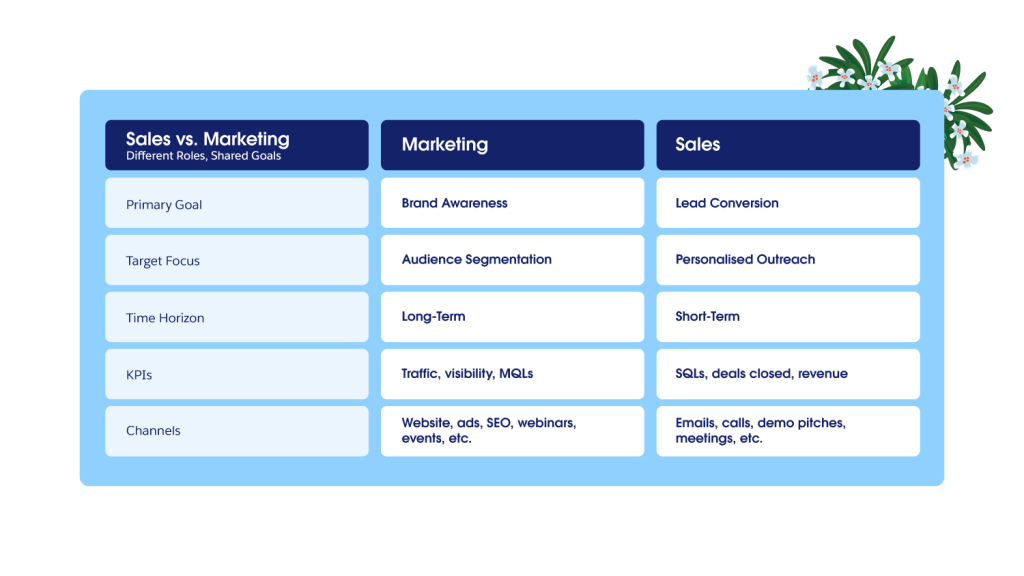In the classic sales vs marketing debate, it’s tempting to pit the two as competitors—one chasing leads, the other chasing quotas. But the reality is far less competitive and far more collaborative. Sales and marketing aren’t opposing forces on the table and in the boardrooms; they’re different gears in the same growth engine. The better they sync, the faster the business grows. And in today’s digital-first world, where buyers tend to self-educate long before they begin talking to sales, that alignment is no longer optional—it’s essential.
The relationship between sales and marketing
Sales and marketing have traditionally been tied together in the corporate world, but are often at loggerheads. However, the relationship is more symbiotic than most stakeholders realise. In other words, it’s not sales vs marketing; rather, it’s sales and marketing.
Why? At the core, both sales and marketing exist to create value for the customer and drive revenue for the company. Marketing creates awareness, fosters brand recognition, and nurtures leads through targeted campaigns, content, and unique experiences. Sales teams take over these leads, turning them into paying customers through pitches, conversations, and timely follow-ups.
The smoother the transition, the faster the wins.
Over the years, the relationship has become even more important. Now that users spend most of their time online, an average B2B buyer is 70% through the buying journey before their first contact with the sales team. In such a scenario, marketing not only supports the sales funnel but also helps push for the remaining 30% decision.
With such mutual accountability, shared data, and a deeper alignment between the departments, companies can expect:
- Shorter sales cycles
- Greater brand trust and visibility
- Higher win rates
- Increased customer lifetime value (CLV)
Sales vs Marketing: Breaking down the differences
To truly understand the dynamics between these departments, we need to examine their core functions, how these teams operate, and the unique value they bring to the table. It also becomes equally important to understand the core differences between these functions. Here’s how sales and marketing differ:
Primary Goal
- Marketing: Builds brand awareness and attracts interest from potential customers.
- Sales: Converts qualified leads generated by marketing into paying customers.
Target Focus
- Marketing: Segments the audience and develops detailed buyer personas to guide messaging and campaigns.
- Sales: Engages directly with prospects—at the account or individual level—using personalized sales outreach.
Time Horizon
- Marketing: Focuses on long-term strategies that build brand equity and keep the business top of mind.
- Sales: Executes short-term efforts to turn qualified leads into closed deals.
Key Performance Indicators (KPIs)
- Marketing: Tracks metrics like website traffic, brand visibility, and marketing-qualified leads (MQLs).
- Sales: Measures success through sales-qualified leads (SQLs), closed deals, and revenue generated.
Channels
- Marketing: Uses digital and event-based channels such as websites, paid ads, SEO, webinars, and industry events.
- Sales: Connects with prospects through direct emails, calls, product demos, and one-on-one meetings

While the tactics, timelines, and KPIs differ, both sales and marketing share the ultimate goal of driving business growth. However, now that the customer journeys have changed drastically, these departments cannot work in silos. Marketing teams cannot simply hand off the leads; they have to work alongside the sales team to guide the customer throughout the journey.
But how does this collaboration look in real life?
Collaboration over competition: Why sales and marketing need to be in sync with each other
The LinkedIn ABM Guide claims that when marketing and sales are tightly aligned, marketing-generated growth increases by a whopping 208%. Why? Because it removes the friction from the customer journey. Messaging becomes consistent, timing gets sharper, and the handoff from marketing to sales feels seamless. And when the process flows better for the customer, conversions follow.
So, what does real collaboration between sales and marketing look like?
- Agreeing on what matters
Start with the basics. What’s a qualified lead? When does it move from MQL (marketing qualified lead) to SQL (sales qualified lead)? Collaboration begins with clarity. Without a shared vision, you’re playing the same game with different rules. - Feedback that flows both ways
Sales teams speak to prospects every day—they know what’s landing and what’s not, especially in terms of strategies, content and overall campaigns. When they share this feedback and the marketers listen, campaigns improve. - Using the same tools, not working in silos
Suppose marketing and sales use different platforms- it’s easy to lose sight of the full picture. A shared CRM or integrated platform—like Salesforce C360—helps both teams track lead activity, measure intent, and deliver the right message at the right time. - Looking at the same scorecard
When KPIs are aligned, so are priorities. Instead of marketing celebrating leads that sales can’t close, or sales chasing deals that marketing never targeted, you’ve got a unified funnel and shared wins.
Sales and marketing don’t need to fight for credit. When they join forces, tactics like account-based marketing become more powerful. And prospects don’t feel like they’re being passed between teams—they get a consistent experience from start to finish.
Strategies and methods that define sales and marketing functions
While collaboration is important, marketing and sales play different roles. Understanding when to pass responsibilities, pivot strategies, and push forward depends on knowing each function’s role and where they can intersect.
Marketing functions: Build, attract, nurture
Marketing’s function is to ensure that your brand’s name pops up when customers have purchase intent, i.e., earning attention before the ask. Here’s how they do it:
- Content marketing: With content, it’s not about selling; it’s about solving. Blogs, videos, and infographics are ways marketing educates and engages your target audience.
- SEO and paid media: Apart from managing the brand’s overall online presence and reputation, marketing also focuses on specific aspects such as SEO and paid media. The aim is to improve discoverability through search and targeted ads.
- Lead nurturing campaigns: Once the prospects have shown interest, marketing must keep them active till they show purchase intent (when sales take over). This can be done through newsletters, email sequences, retargeting ads, etc.
- Brand positioning: Marketing defines how your brand is perceived in the market, shaping the reputation long before sales conversations begin with prospects.
Sales functions: Engage, qualify, close
Once curiosity becomes interest, sales takes over from marketing. They build trust, identify which solution fits the customer’s needs best, and help buyers take action.
- Demo and discovery calls: As soon as the interest becomes real, sales teams reach out to the customer to understand pain points, align solutions, and customise their pitch accordingly.
- Consultations: Sales representatives also act as advisors, identifying any additional problems users might face before pitching relevant solutions. According to the latest Salesforce State of Sales report, 87% of buyers prefer sales reps acting as trusted advisors.
- Outbound prospecting: Sales also handles new conversations through cold calls, LinkedIn outreach, cold emails, etc. Strategic, personalised efforts are required to generate interest when prospects have not shown interest, but they align with the product market fit.
- Objection handling: Prospects rarely agree to buy right away. Sales plays a crucial role in turning those initial “nos” or “maybes” into “buy-ins” by building trust, answering objections, and staying persistent.
Where do sales and marketing functions align
There are instances where sales and marketing have to co-exist and collaborate for success. These include:
- Account-based marketing: ABM is a strategy where marketing targets high-value accounts with personalised messaging, and sales teams follow up with personalised outreach.
- Events and webinars: Marketing builds interest for the events and drives registrations, while sales takes over post-event to engage attendees and convert leads.
- Product-led growth models: Marketing generates interest and drives sign-ups, while sales steps in and upsells power users and turns them into paying customers.
Essential tools that support both sales and marketing teams
Even the best strategies can fall flat without the right tools. For sales and marketing teams to truly align and deliver impact, they need a solid tech foundation that keeps everyone on the same page and moving toward shared goals. This includes:
Customer relationship management (CRM)
A CRM is the heartbeat of a sales and marketing setup. It helps track leads, monitors pipeline health, forecasts revenue, and records every interaction—so nothing slips through the cracks. With Salesforce CRM, both teams can build and grow relationships across the entire customer lifecycle, while getting a single, real-time view of every customer touchpoint with shared data.
Why it matters: On a shared ecosystem, you can store, track, and analyse customer and prospect information in one central location, including contact and account information, sales opportunities, service cases, and marketing campaigns.
Marketing automation platforms
Marketing automation helps you scale without losing the human touch. Platforms like Salesforce Marketing Cloud enable personalised journeys, behaviour tracking, lead scoring, and automated outreach that can adapt quickly.
Where simple automation is not enough, AI can step in. By leveraging custom AI agents—like the ones Agentforce can help you build—both sales and marketing teams can get AI assistance for just about every process, task, or decision.
Why it matters: Sales teams don’t waste time on cold prospects, and marketing can nurture leads till they are ready to purchase.
Analytics and attribution
Decisions are better when backed by numbers. With the right analytics tools, you can see what’s driving results—from ad spend and CTRs to pipeline velocity and closed deals.
Why it matters: With data backing your efforts, sales can move faster, and marketing stays relevant without unnecessarily reinventing the wheel.
Collaboration and alignment tools
These might not always make it into the official sales-marketing tech stack, but they’re essential. Tools that support real-time updates, shared dashboards, and cross-functional visibility—like Slack—keep things moving.
Why it matters: Dashboards show numbers, but departmental alignment happens in conversations, documents, and shared goals.
Common myths around sales vs marketing
Despite all the influence sales and marketing have, there are wide misconceptions surrounding how they should operate—even among those working in these teams.
Myth 1: Marketing’s job ends once the MQL is generated
Truth: Modern buyer journeys are erratic. Marketing can no longer attract leads and call it a day; they have to educate, nurture, and make the leads sales-ready. Additional roles include post-lead engagement, reactivation campaigns for leads that have fallen through, and retention.
Myth 2: Sales is just about closing
Truth: Closing is the outcome, not the identity. Great salespeople are not pushers but consultants. They diagnose the problems by asking the right questions and customising solutions based on what the leads need. Conversion happens through trust, not pressure.
Myth 3: Sales and marketing don’t need to talk
Truth: Inter-departmental silence can be expensive. When sales and marketing operate in silos, leads will fall through the cracks, messaging will become inconsistent, and customers will simply stop trusting the brand. Collaboration is crucial for smooth operations.
Myth 4: Marketing is “creative”/Marketing is there to make things look pretty
Truth: Creativity is critical, but aesthetic value is not enough in today’s world. Marketing today needs to be data-driven and technical—from attribution modelling to A/B testing, modern marketers live and breathe metrics.
Myth 5: Sales gets all the credit
Truth: Sales closes the deal, but marketing opens the door to those conversations. Recognition should follow results, not visibility. Shared wins boost mutual respect.These persistent myths don’t just damage team dynamics, they represent an outdated model that modern companies have long discarded. Successful organizations have shifted focus toward RevOps (revenue operations) models where critical go-to-market functions, including sales and marketing, are integrated into the customer journey to drive better outcomes and greater growth.
Final Thoughts: Bridging the Gap for Business Growth
While sales vs marketing is still a debatable topic in legacy organisations, new-age companies are already finding ways to bridge this gap. It’s not about who matters more, but how well they work together and how, when aligned, they build better buyer journeys, stronger brand trust, and long-term growth.
If your sales and marketing teams still tend to operate in silos, it’s time to rewrite the playbook. Align incentives, unify systems, and give both sides the data and tools to function as one. Because growth doesn’t come from working in parallel—it comes from working in sync.
























